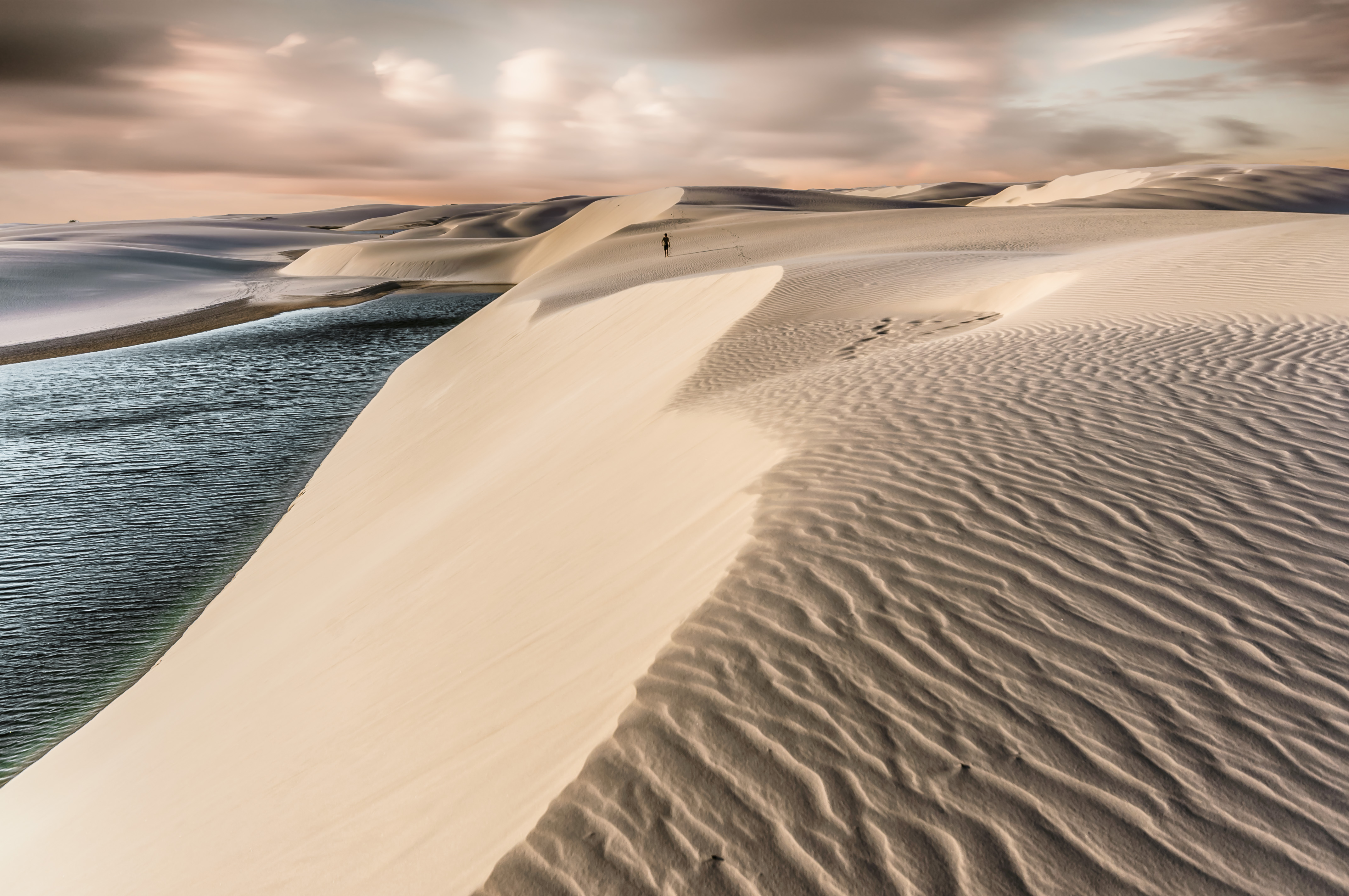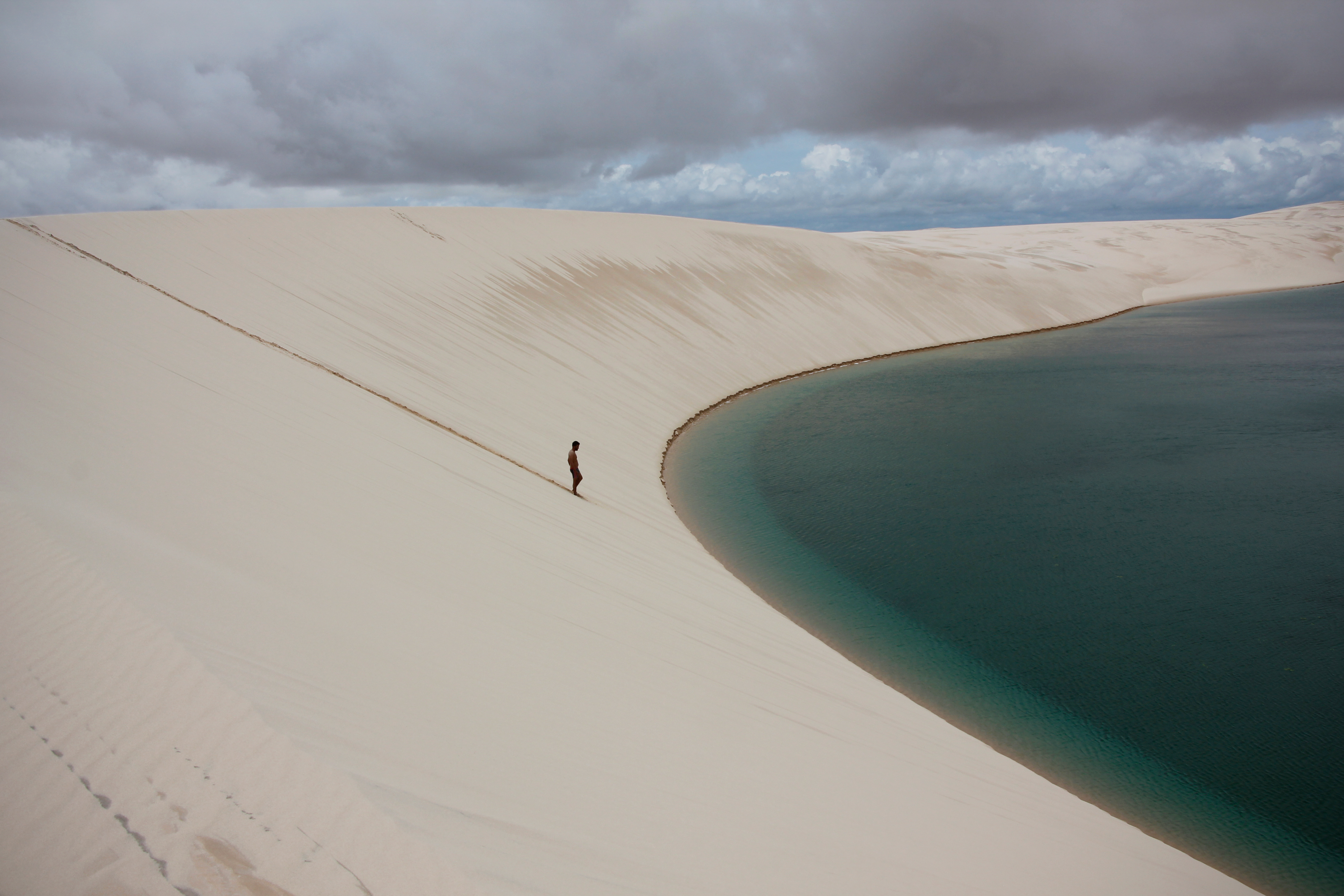Brazil's North-East Region
Lencois Maranhenses Travel Guide
Do you know what happens when it rains on pristine, white sand dunes? This unique national park has the answer.

Lençóis Maranhenses National Park, located in Maranhão, is a unique desert-like landscape of vast white sand dunes that fill with turquoise freshwater lagoons during the rainy season. The park offers breathtaking views, especially during the rainy season when the lagoons fill up. Visitors can enjoy buggy tours, guided multi-day treks, sandboarding, and swimming in the lagoons. Barreirinhas is the main gateway to the National Park, but you can also get there via Santo Amaro do Maranhao.
Top 5 Things to See & Do in Lençóis Maranhenses
Swim in Lagoa Azul
Take a multi-day hike across the dunes
Go sandboarding on the dunes
Explore the village of Atins
Take a boat trip on Rio Preguiças
It is possible to book tours directly in Barreirinhas upon arrival. For those who prefer to book in advance there are several highly recommended tours to chose from at reasonable prices, including this sunset tour of the Bonita Lagoon Circuit.
Where is Lencois Maranhenses, Brazil
Closest airport
Marechal Cunha Machado International Airport (São Luís Airport) (SLZ)
Main bus terminal
Rodoviaria Cisne Branco (Barreirinhas)
N/A
Main ports
How to get to Lencois Maranhenses
To visit the Lencois Maranhenses National Park, you will need to travel to one of the park's main entrance points in Barreirinhas or Santo Amaro do Maranhão.
How to get to Lencois Maranhenses from Sao Luis
Option 1. Visit Lencois Maranhenses via Barreirinhas
First, take a bus or van from São Luís to Barreirinhas. The bus company Cisne Branco departs five times per day from Rodoviária de São Luís and arrives at Rodoviária Cisne Branco. Once in Barreirinhas, there are a variety of tours available that will allow you to visit the park.
Option 2. Visit Lencois Maranhenses via Santo Amaro do Maranhão
There are no direct bus routes to Santo Amaro do Maranhão as the final part of the journey must be made by a 4x4 Jeep, due to the sand. There is no public bus, instead you will need to book a van transfer from São Luís. The van will take you as far as possible, and then you will transfer to a 4x4. There are several companies offering this transfer.
How to get to Lencois Maranhenses from Fortaleza
There is currently no direct bus to Barreirinhas to or from Fortaleza. You will need to transfer through Sao Luis by plane or by bus.
How to get to Lencois Maranhenses from Jericoacoara
There is currently no direct bus between Barreirinhas and Jericoacoara. Instead, you will need to take a private or shared transfer service. There are various companies available - RotaCombo is one company that offers a shared transfer on Tuesday, Thursday and Saturday from Barreirinhas to Jericoacara, and returns Monday, Wednesday, and Friday from Jeri to Barreirinhas.
How to get around Lencois Maranhenses
Tours are the easiest way to visit the park. Tours are varied and include including visiting the dunes in 4x4 Jeeps, on foot with multi-day hiking tours, and even horse-riding.
If you don’t want to take a tour, it’s possible to walk to the park’s most famous attractions - Lake Azul and Lake Bonita. To explore the dunes by car, you need a 4×4 Jeep as well as prior authorization to drive in the park.
How to get to Atins from Barreirinhas
To get to Atins from Barreirinhas, you can take a 40 minute boat ride along the Preguiças River from Barreirinhas, which offers scenic views with stops at local attractions like Vassouras, where you may encounter capuchin monkeys, and the Mandacaru Lighthouse. Alternatively, a 4WD vehicle from Barreirinhas can take you through the dunes to Atins. Along the way, you'll pass through mangroves, and quiet fishing villages like Caburé.
Things to know before you go
There are two main entrances to the Lencois Maranhenses National Park, each offering access to different attractions. Barreirinhas is arguably easier to reach, as it is accessible by public bus, and has more established tourist infrastructure. However, Santo Amaro is located closer to the dunes and provides the opportunity to walk to the dunes directly from your guesthouse. Ultimately, your choice will depend what you cant to see and whether you plan to take the multi-day dune hike.
Here are some of their nearby attractions to help you decide where to go in Lencois Maranhenses:
Attractions near Barreirinhas
Lagoa Azul Circuit (Blue Lagoon Circuit): One of the most popular attractions in the region. After a 12 km ride through coastal vegetation, you’ll reach the dunes, with a 2 km trail ahead. Along the way, you can visit Lagoa da Preguiça (Sloth Lagoon), Lagoa da Esmeralda (Emerald Lagoon), Lagoa Azul (Blue Lagoon), and Lagoa do Peixe (Fish Lagoon), which stays filled year-round. This is the only attraction accessible with traditional vehicles, but prior authorization is required from the National Park administration.
Lagoa Bonita Circuit (Beautiful Lagoon Circuit): Located 15 km from Barreirinhas, this route requires climbing a 30-meter-high dune, with a rope provided for assistance. The climb is rewarded with stunning views of the dunes and surrounding coastal vegetation. Afterward, it’s a short walk to Lagoa Bonita. You can also visit Lagoa do Clone, made famous by the Brazilian soap opera “O Clone,” filmed here in 2001.
Lagoa da Esperança (Hope Lagoon): This lagoon is formed by the Negro River meeting the dunes, making it a permanent feature. Unlike other lagoons, it’s located on the edge of the dunes, providing access to both the water and the dune fields. Ideal for visiting during the dry season when other lagoons may be empty. Lagoa da Esperança is near the borders of Barreirinhas and Santo Amaro.
Atins: A peaceful village located at the mouth of the Preguiças River, just outside the National Park. Perfect for visitors seeking tranquility and a close connection to nature. In Atins, you can enjoy beach walks, explore dunes, and practice sports like kite-surfing, wind-surfing, kayaking, paddleboarding, and cycling. The village is simple, with a laid-back vibe and a chance to experience local culture.
Canto dos Lençóis (Lençóis Quarter): Situated within the National Park, this small fishing village offers views of the dunes and is close to the beach. With no electricity, the village has simple accommodations and community-run restaurants serving traditional meals. It’s an excellent starting point for trekking across the dunes to Santo Amaro.
Circuito Foz do Rio Negro (Negro River Mouth Circuit): Starting from Atins, this route follows the beach within the National Park. The main highlight is where the Negro River meets the sea, offering the chance to bathe in small waterfalls. This attraction is available when the river has water, so check ahead with park administration or local guides. You can also visit Lagoa Verde (Green Lagoon), a 30-minute walk from the dunes that holds water for most of the year.
Attractions near Santo Amaro
Lagoa da Gaivota (Seagull Lagoon): A top attraction in Santo Amaro, known for its birdwatching opportunities in a seagull nesting area. Other highlights include Lagoa da Andorinha (Swallow Lagoon), Lagoa do Cajueiro (Cashew Tree Lagoon), and Lagoa do Maçarico (Solitary Sandpiper Lagoon), ideal for kite-surfing. On the way, you’ll pass Lago de Santo Amaro. You can reach this spot via walking trails or accredited 4x4 vehicles.
Lagoa da Betânia (Betânia Lagoon): Similar to Lagoa da Esperança, this lagoon is created by a river meeting the dunes. Located in the village of Betânia, it offers basic services. The ever-changing water colors and the dramatic backdrop of dunes make this a unique destination.
Lagoa das Emendadas (Emendadas Lagoon): Accessible only by foot, this series of interconnected lagoons extends for several kilometers through the dunes. This location offers a clear sense of the immense scale of the Lençóis Maranhenses National Park.
Praia da Travosa (Travosa Beach): Located near the fishing village of Travosa, this beach features a wide stretch of sand with the dune fields as a backdrop. A regional surf competition is held here every April.
Hiking in Lencois Maranhenses
The "Primitive Zone" is a protected area in the heart of Lençóis Maranhenses National Park, accessible only by hiking. A hike through the dunes and beaches can take four to five days, with overnight stays in local communities. Hiring a guide is mandatory, as the challenging terrain, lack of cell coverage, and remote nature of the area can make navigation difficult. The hike is always done from east to west due to the wind and shape of the dunes, and begins in Barreirinhas.
Within this zone are the two oases of Queimada dos Britos and Baixa Grande. These areas, home to around 30 local families, are among the most biodiverse spots in the park, with lagoons for swimming throughout most of the year. Due to strict conservation regulations, only minimal-impact visits are allowed, prohibiting motorized vehicles except for residents.
More tips for visiting Lencois Maranhenses
Best Time to Visit: The stunning blue and green lagoons of Lençóis Maranhenses are only filled with water between May and August, following the rainy season (from January to May). During these months, the rainwater collects between the sand dunes, creating the famous multicolored lagoons. Outside of this period, the lagoons can dry up.
Remote Location: Lençóis Maranhenses is a remote national park in northern Brazil, with no roads directly within the park itself. You’ll need to travel by 4x4 vehicles, often from the town of Barreirinhas, or by boat.
Limited Facilities: Facilities within the park are very basic, with few food and drink options available once you're inside. It’s a good idea to pack snacks, plenty of water, and any essentials you may need for the day.
Pack for the Heat: The park consists mainly of large sand dunes, and the heat can be intense, particularly midday. Bring plenty of sunscreen, a hat, and lightweight, breathable clothing to stay comfortable as you explore the dunes. Bringing plenty of water is essential.
Bug Repellent: Although Lençóis Maranhenses is mostly a desert-like environment, the lagoon areas can still attract mosquitoes and other insects, especially after the rainy season. Be sure to bring insect repellent to avoid bites during your visit, especially around dawn and dusk.



Disclaimer: Some of my pages contains affiliate links, which means that if you purchase a ticket through these links, I may receive a small commission at no extra cost to you. This helps support the blog and allows me to keep providing helpful content. Thank you for your support!








